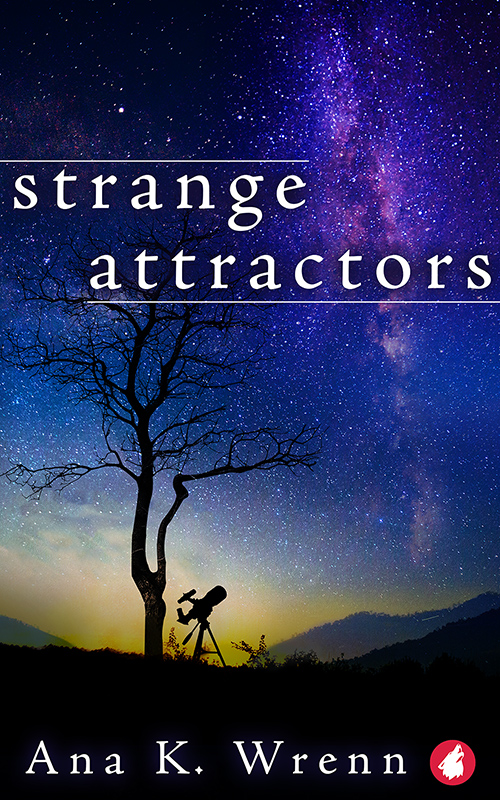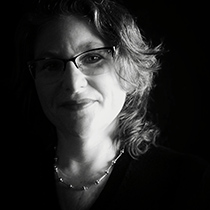Ylva would like to introduce its newest author, Ana K. Wrenn. Her debut sapphic novel, Strange Attractors, is set in dark academia in Appalachia and has aspects of romance, psychological thriller, and suspense.

Tell us about yourself, Ana. The good, the bad, and the ugly!
I’m a second-generation college professor (took after my father) in the U.S. Southern Appalachian Mountains.
The good is that I carved out a career in a part of the country where women are chronically underpaid. The bad is that the demands on teachers are increasing, and the pandemic only exacerbated the situation. And the ugly… We have politicians telling us what we can’t teach in the classroom (racism, sexism, homophobia)—not to mention the gun violence that those in education face. It’s a challenging time for educators.
While I’m planning on leaving academia soon, I love that I’ve taught generations of students.
Is there something—a food, place, or experience—that’s uniquely Appalachian that you love?
The woodlands. Whenever I’ve moved out of Southern Appalachia, I’ve gotten soul sick.
I love sunlight filtering through the canopy overhead, or rain showering oak, maple, and poplar leaves.
There’s a perfume here, especially in the deep, moist parts, a mingling of hemlock, cedar, oak, and humus-y soil. Also, I love damp moss under my naked feet and spongey soil under my boots.
Ahhhhhh…
Let’s talk ice queens. You may have written the frostiest professional woman in sapphic history. How did Professor Sonja Storey come about?
The Professor Storey kind of woman was often my favorite teacher. Now that I think about it, I remember this one teacher I had who wore impossibly high heels and never cracked a smile. When I complimented her, she would frost over—like a frozen, pale rose, beautiful and thorny. I loved her. She was highly intelligent, committed, and, above all, untouchable.
This book is a love poem to all the Professor Storeys out there.
What motivates this ice queen? Why is she at war with the world?
A glacier doesn’t become a glacier overnight; there are hard, compressed layers. Sonja is the same.
Glaciers either move alone on a great expanse of water, or they spread across land; I think that’s what Sonja wants in some ways. She wants to do life on her own. She wants her path to be unimpeded, and when she expands into a territory, she wants to do that without obstacles.
Perhaps under the right circumstances, she will melt, but do we really want glaciers to melt? Isn’t their inaccessibility what makes them gorgeous and valuable?
How does someone so uptight deal with the other protagonist, laid-back Crystal Byrd?
In some ways, Dr. Crystal Byrd is aspirational to Sonja, not that she would admit that to herself. Crystal is strong enough to be vulnerable, to be tender.
Though younger, Crystal understands how some women have had to ice over to survive, and she isn’t afraid of exploring a harsher relational terrain. Still, she has good sense: she won’t remain in an unwelcoming place—and Sonja is proving to be highly unwelcoming.
Unusually for most sapphic books, you send a protag off for therapy. Why that path?
At some point, an ice queen must crack or melt.
Sonja’s icy ways work up to a point, but she’s learning that being hard and jagged all the time comes at a price.
What was tricky for me was figuring out how to get her into a therapist’s office in an authentic way that respects her personality and her journey.
Chaos theory features prominently throughout your book. Why was this a metaphor for what’s going on in the story?
As a communication professor, I’m fascinated with the butterfly effect: little movements (acts, words) can produce seismic results. Even well-intentioned acts can produce problematic, sometimes inhumane, outcomes.
I like to put powerful women into situations where they act in ways that they think are empowering, beneficial. Do those ways create more order? Are those acts helpful in the end? Or might they inadvertently magnify chaos?
Why set a book in dark academia, and why choose Appalachia for the backdrop?
When it comes to Appalachia, stories about women, queers, and communities of color have been largely erased. I write about the people I want to read about.
That goes for academia too. Academia is a stage where human dramas unfold. There’s love, treachery, and renewal on college campuses. But our stories about academic worlds shouldn’t only be about twenty-somethings or white cishet male professors.
Female professors aren’t just replacement mothers, patiently waiting for opportunities to nurture and transform young people. Instead, we have our own stories that must be showcased on the larger stage.
What is your writing process? Destroy a whole weekend? Write before work?
I admire writers who squeeze writing into the cracks in their busy days. I am not one of those writers, however. I block out days for teaching, grading, and other professor-ing work. Then, on weekends and breaks, I obsessively outline, plan, write, and revise.
The cats apparently like when I sit for long spells and type while they snuggle and sleep. Kia and Luna (the dogs) would prefer more walking, but they seem content to sit beside me on the sunny deck while I type away.
When did you first start scribbling fiction?
I have a vivid memory of being around eight years old in my shoebox-size bedroom, as I sat on the hardwood floor and scribbled my first story. That story was about an alien that visited earth. I don’t remember much beyond that, but what’s telling is that from the very beginning, I’ve been drawn to outsiders—those who are trying to figure out how to operate in a strange, sometimes hostile world.
Are you an avid reader? What type of books?
Oh, I constantly read, and I read across genres, including research and nonfiction.
I begin my day with a poem. Mary Oliver, Audre Lorde, and Edna St. Vincent Millay are my favorites, all queer women writers, by the way. Then, I move to an inspirational book, like something from bell hooks (a queer, feminist Appalachian too!), and I end the day with a fiction book.
Right now, I’m reading The Island Between Us by Wendy Hudson, and before that The Once and Future Witches by Alix E. Harrow.
Recently, I finished Shattered by Lee Winter, and I loved it—it’s such a delicious and smart exploration of human nature, and I came out both edified and recharged.
What do you think makes a good story?
I’m drawn to what Joseph Campbell called the Hero’s Journey: the hero encounters trials and tribulations, overcoming them and emerging changed.
But I find the human experience interesting enough without adding all kinds of conflict or adventure. Trials and tribulations take various forms, like a hero’s emotional journey—I’m thinking Toni Morrison and Elizabeth Strout in particular.
What was the hardest thing for you about writing Strange Attractors?
I’m drawn to complex women, but I understand that in real life, being around difficult personalities is challenging.
So, I wanted to figure out how to flesh out Professor Storey—a cold, marble statue on the outside—in such a way that readers would be willing to snuggle up to her at the end of a long, hard day.
What did you want to be as a child?
Everything.
Seriously, one day I wanted to be a teacher, a nurse the next. I briefly thought about being a surgeon and astronaut (not to be confused with a surgeon-astronaut). Then, in high school, I discovered acting (where I could be everything), and in my 20s, I realized that there had been one constant: writing.
Favorite three books or authors?
NOOOOOO!!! Just three? I’m going to cheat. In alphabetical order:
An American Marriage, Tayari Jones
Fingersmith, Sarah Waters
Kindred, Octavia E. Butler
Method 15/33, Shannon Kirk
Out, Natsuo Kirino
Requiem for Immortals, Lee Winter
Shattered, Lee Winter
Slammerkin, Emma Donoghue
The Overstory, Richard Powers
Okay, okay! I’ll force myself to stop there, but there are MORE!!
How did you choose your writing pseudonym?
My last name is inspired by one of my favorite birds, the Carolina wren, a tiny, feisty bird. My first name is a variation of the spelling of my legal middle name, and the K.—well, we’ll keep that a secret.
Together, though, when I say Ana K. Wrenn, it reminds me of one of my all-time favorite writers, Anais Nin. Oh no! I didn’t add her to the fave list above!
If talent and money were no factor, what bold job would you love to do?
Full-time writer (and maybe the occasional acting gig and lounge-club singing performance).
What are you writing now?
A slightly futuristic novel that is all things I love: a foe-flame, sapphic, dark tale intertwining wild spaces, dark academia, and unethical research. I can’t wait to share it with you.

Ana K. Wrenn is a writer and professor who calls Southern Appalachia home. Strange Attractors is her first book. When she’s not writing, you can find her hiking in a forest, hanging on the deck with her two dogs, or snuggle-reading with her three cats. And, yes, all members of the fur family are rescues. You can follow her on Twitter, Instagram, and Facebook. Also, fly over to the Wrenn’s Nest at https://anakwrenn.com.


great read. First Sonja bothered me with that icy personality.
later with her friend and lover she showed how to melt.
intimacy scenes done discreetly.
development of characters well done.
Thanks so much for reading this and popping by to say hi! Sonja bothered me too, but to write her, I had to find her beauty. Thanks for sticking by her, and my debut novel.
Great interview 🙂 Appalachia sounds beautiful.
I love this. This is what loving Ice Queens is all about:
“Perhaps under the right circumstances, she will melt, but do we really want glaciers to melt? Isn’t their inaccessibility what makes them gorgeous and valuable?”
Thanks for dropping by my neck of the woods 🤗 Oh, I adore Ice Queens too, something I became even more aware of as I wrote Dr. Sonja J Storey into being–or more accurately, she demanded I write her into our world. 😄🤗 Thanks for reading the interview.